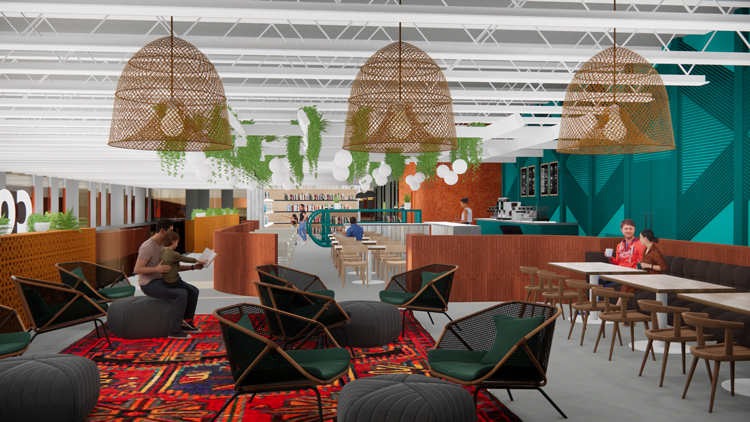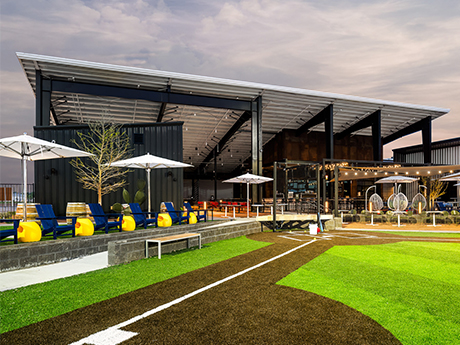Entertainment is playing an increasingly important role in the industry, anchoring both new and redeveloped projects and bolstering efforts to backfill large-format boxes. Shopping Center Business recently sat down with Nicole Poole, vice president of hospitality and entertainment at HFA Architecture + Engineering, to chat about design trends in this fast-growing segment. The veteran hospitality architect helped Topgolf develop its concept and currently works with the likes of Home Run Dugout, Blue Jeans Golf, Happy Dave’s, WorldSprings and Smash Park.
SCB: What are some emerging design considerations in this category?
Poole: Integrating tech and AI continues to be a big subject. But it’s interesting, I just hosted a roundtable discussion at SCB’s Entertainment Experience Evolution (EEE) conference, and there was a lot of interest in getting back to what is sometimes described as human-centric design. It’s what you traditionally see in hospitality, right? Maybe you check in at a nice hotel and notice that there’s a welcome message for you on the flatscreen TV in the lobby. Or when you come back down, the receptionist waves and greets you by name. As we design the next generation of tech- and activity-driven entertainment concepts, it’s important to stay cognizant of the need to keep creating these kinds of special, memorable moments for people. When they’re waiting for a pickleball court, where are they going to go, and what are they going to do? Designers and architects really need to put themselves in people’s shoes and imagine what those guests are going to experience throughout their entire journey.
SCB: And I guess these days that might include their virtual journey — what they’re experiencing on their phones or with the tech at that concept?
Poole: Absolutely. It’s not an either/or thing — it’s both/and. When someone takes off their VR helmet, will someone be there to greet them or will they be all alone? Have they just been through a spine-tingling horror experience with a bunch of jump scares, or was it a chilled-out exploration of ancient Greek ruins with classical music? It’s important to understand the guest’s likely emotional state, because it could inform how you want their next experience to be, or how you train your staff to interact with them once that VR helmet is off. During our EEE roundtable, one exec said he didn’t think tech played any role in the experience that his entertainment concept provided. As he saw it, a human-centric approach was just about making sure people were enjoying the experience. We had a robust debate over that, because these days, more often than not, there will be some kind of tech interaction. Maybe you’re checking in and out on an app or using it to keep score. You just want to make sure you don’t overlook opportunities to better integrate that dimension into the journey. For example, if the app is glitching out, is there someone nearby to help or a way to call for help?
SCB: What’s the best approach to mapping out these kinds of experiences?
Poole: If you’ve got a big-box retail store with commoditized hard goods kind of stacked to the rafters, it might be OK to create a more-or-less uniform customer journey, because the majority of your customers are there for the same things and will be using that space in pretty much the same way. Entertainment concepts are a bit different. Arguably, it’s a lot more important to understand the differences among your guests. Those differences have the potential to really change how your guests use and flow through the space. Let’s say you’ve got a sports-themed concept. You could have one customer segment that’s all about the entire family playing pickleball or golf and another that’s really about parents bringing their kids to play and then watching the match. What’s the experience going to be like for those parents? Is the seating comfortable or are you planning to use aluminum folding chairs? Are you missing out on an opportunity to sell them food and beverages in a concession area while they spectate?

SCB: Generally, do entertainment concepts study these different guest experiences?
Poole: It varies. When architects and designers — or for that matter, landlords — first meet with an entertainment concept, I’d recommend finding out exactly what that group understands about its different customer segments. Some operators maintain detailed brand books packed with customer data. They might even have created names for different segments — ‘Gamers’ from 12 to 35 years old, for example, or ‘Neighborhood Hangouts’ from 26 to 50-plus. If they haven’t done that, and if the operator has one or more concepts up and running, we’ll often make site visits and observe how different types of guests are using the space. You can get really interesting insights: ‘Oh, we’re actually seeing a lot of elderly couples come to this health-and-wellness concept.’ At your next location, you could shorten the walks to some of the activities. It might also help to have a family changing room nearby where they can go in together and help each other. Direct observation can be really valuable. Brokers and research departments often have a ton of demographic data. Traditionally, architects and designers haven’t asked for that information, but we think having it can really bolster the design process. You can also just quiz the operator’s real estate people and executive team. Even if they don’t have a lot written down, they will still have a good idea of who will be coming to play pickleball. Talk to them about it.
SCB: Are there any other dimensions to consider?
Poole: One interesting client I’m working with right now is called WorldSprings. They’ve got 40 different soaking pools that replicate specific therapeutic springs from all over the world, along with saunas, spas and food and beverage. Some people are there for a solitary experience, while others want to be social, so we’ve designed spaces that accommodate those different needs. Another dimension is time. Along the lines of a morning yoga class, people going to WorldSprings early in the morning are doing so for prevention and health and wellness. That calls for a softer approach to sound and lighting. At night, the motivation shifts more to socializing and hanging out. The pools are lit up and the music can be more energetic. At a lot of entertainment concepts, the ebb and flow of customers varies as the day progresses. Designers should take this into account. Lastly, I’d say entertainment design really should prioritize comfort and ease — reducing friction throughout the journey. Why make someone wait in a small, crowded space when you could give them a pager that lets them roam around and explore other interesting experiences that you have created for them? Giving people memorable experiences so that they want to come back is really the core of all of these discussions. That’s why human-centric design is such a valuable lens. By putting yourself in your guests’ shoes, you can forge human connections and encourage people to say to themselves, ‘This place is great. I could easily see myself coming back here every week.
— Interview conducted by Randall Shearin. This article appeared in the June issue of Shopping Center Business.


